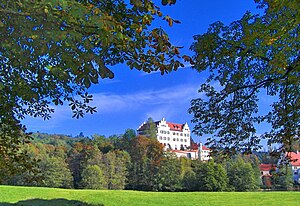Duttenstein Castle
The Duttenstein Castle is a former hunting lodge in the style of the Renaissance with large wildlife park . It is located near Dischingen , the easternmost district of Baden-Württemberg in the Heidenheim district . In the immediate vicinity of the castle, there is the former Parkjägerhaus and at the bottom at the entrance there is a residential building that belonged to the former estate. An old (partially ailing) chestnut avenue lines the way to the castle.
history
The three-storey, walled, four-wing complex (the so-called high castle) as the main building, with an intermediate structure, park hunter's house and free-standing clock tower, was built from 1564 to 1572 on a rocky hill instead of an early castle (first mentioned in 1374 as Tuttenstain Castle ). It is provided with an inner courtyard, tin gables and bay windows. A circular wall with two round towers encompasses the entire high castle, partly polygonal, partly rounded. In front of this is the pre-castle with the castle courtyard and servants' house.
In 1551 Anton Fugger von der Lilie acquired the rule of Duttenstein from Knight Hans Walther von Hirnheim, whose second oldest son, Hans Fugger, had the castle built. In 1735, Eustach Maria von Fugger sold the Duttenstein reign to the second Prince of Thurn and Taxis , Anselm Franz von Thurn and Taxis , who tried to gain a seat and vote in the Reichsfürstenkolleg at the Reichstag in Regensburg by acquiring several princely territories.
The remodeling carried out in 1792 by the fourth Prince of Thurn and Taxis, Karl Anselm von Thurn and Taxis , who commissioned the Augsburg painter and academy director Johann Anton Huber with the painting of several rooms, e.g. B. the prince's room on the third floor. The last-named prince came to Duttenstein for a long time with a small retinue from the Taxis Castle (Trugenhofen) , which was one of his favorite places.
His successor, Karl Alexander von Thurn und Taxis, had an approx. 500 hectare fenced game park built around the castle in 1817 .
During the Nazi dictatorship, the castle was occupied by the SS . After 1945, Polish Jews who had survived the reign of terror of the Third Reich lived there. A lung sanatorium was housed from 1947 to 1975. The sick were cared for by the Order of the Brothers of Mercy from Silesia.
Since 1996, the laboratory entrepreneur Bernd Schottdorf (1940-2018) was the owner of the castle, which he renovated. The building cannot be visited. The wildlife park with fallow deer and mouflons is open to the public every day from sunrise to sunset. The castle owner kept large parts of the wildlife park cordoned off.
literature
- Günter Schmitt : Castle Guide Swabian Alb, Volume 6 - Ostalb: Hiking and discovering between Ulm, Aalen and Donauwörth . Biberacher Verlagsdruckerei, Biberach an der Riß 1995, ISBN 3-924489-74-2 , pp. 67-76.
- Martin Kluger: The Fugger. The German Medici in and around Augsburg . Augsburg 2009, p. 188.
Web links
Individual evidence
- ↑ http://www.demmingen.de/KSV/ksv_demmingen_geschichte.htm
- ↑ http://www.zoo-infos.de/set.html?/zoos/704.html
Coordinates: 48 ° 41 ′ 21 ″ N , 10 ° 27 ′ 42 ″ E




